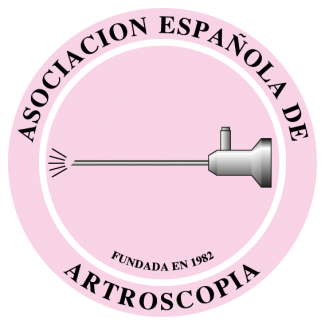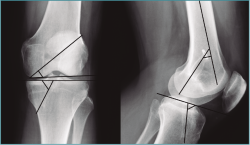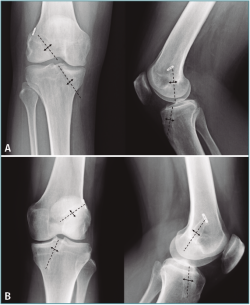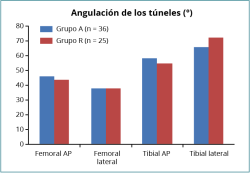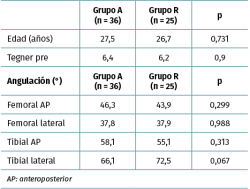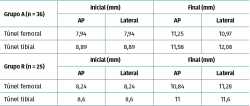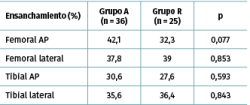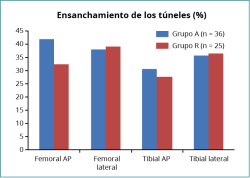Resumen
Introducción: el aumento del diámetro de los túneles tras la reconstrucción del ligamento cruzado anterior (LCA) con injerto de isquiotibiales es una complicación conocida. Este se ha relacionado con variables como: el tipo de plastia, el tipo de fijación y la angulación de los túneles. La fijación con tornillo retrógrado podría disminuir este ensanchamiento, al ser la fijación más cercana a la interlínea.
Objetivo: comparar el ensanchamiento del túnel femoral y tibial en función de la fijación tibial utilizada, tornillo interferencial anterógrado versus retrógrado.
Material y métodos: se revisaron retrospectivamente 177 pacientes intervenidos mediante plastia con injerto autólogo isquiotibial tras rotura de LCA en nuestro servicio entre los años 2010 y 2016. Tras aplicar los criterios de inclusión y exclusión, se incluyeron 61 pacientes en el estudio, que se dividieron en 2 grupos en función del tornillo interferencial utilizado en tibia: anterógrado (grupo A), formado por 36 pacientes, y retrógrado (grupo R), formado por 25, siendo la media de edad y el Tegner previo de ambos grupos similar. Se midió la angulación de los túneles en radiografía anteroposterior (AP) y lateral, y el ensanchamiento de los túneles femoral y tibial en estudios radiológicos seriados, posquirúrgico inmediato y tras un mínimo de 6 meses de seguimiento radiológico.
Resultados: no hubo diferencias significativas en cuanto a la angulación de los túneles femoral y tibial entre ambos grupos. Se observó un ensanchamiento menor del túnel tibial en las proyecciones AP en el grupo R, siendo del 30,6% en el grupo A y del 27,6% en el grupo R. En el túnel femoral el ensanchamiento también disminuyó, siendo del 42,1% en el grupo A y del 32,3% en el grupo R, y similar en ambos grupos en las proyecciones laterales.
Conclusión: en las intervenciones de reconstrucción de LCA mediante plastia de injerto autólogo de isquiotibiales, se observa un menor ensanchamiento del túnel tibial en los casos de fijación con tornillo retrógrado, más cercano a la interlínea.
Nivel de evidencia: III, cohortes retrospectivo.
Relevancia clínica: no realizar un túnel completo y fijar la plastia más cercana a la interlínea disminuye la incidencia de ensanchamiento del túnel y complicaciones a nivel tibial.
Abstract
Introduction: the bone tibial tunnel enlargement after anterior cruciate ligament (ACL) reconstruction with hamstring autograft is a well-known entity seen in different graft techniques and methods of fixation. Many factors may cause this widening like correct tunnel position, type of graft, type of fixation and correct angulations of tunnels. The fixation closest to the joint, with retrograde screw, could decrease this widening.
Aim: to compare the tibial tunnel widening following ACL reconstruction with different methods of fixation, comparing anterograde screw between retrograde screw.
Material and methods: 177 patients with ACL reconstruction where analized between 2010 and 2016. A total of 61 patients were included in the study, and were divided in 2 groups according the tibial fixation: anterograde screw (group A) and retrograde screw (group R), 36 patients in the first group and 25 in the second group. Mean age and previous Tegner scale were similar in both groups. We evaluated angulation and widening of femoral and tibial tunnels measured in anteroposterior (AP) and lateral radiography, after a minimum follow-up of 6 months.
Results: there were no significant differences in the angulations of the femoral and tibial tunnels between both groups. There is smaller enlargement in tibial tunnel in the AP radiographies in group R (30.6% in group A and 27.6% in group R). In the femoral tunnel, the widening also decreased (42.1% in group A and 32.3% in group R). The widening was similar in both groups in the lateral X-rays.
Conclusion: tibial tunnel widening varies with different methods of fixation in ACL reconstruction with hamstring autograft. We observed smaller enlargement of the tibial with retrograde screw fixation, closer to the joint.
Level of evidence: III, cohorts retrospective.
Clinical relevance: to make an incomplete tibial tunnel and the fixation of hamstring autograft closer to the interline reduces the incidence of tunnel widening and complications in the tibia.
Artículo
Figuras y tablas
Referencias
Descargas
Licencia
Este contenido es de acceso abierto (Open-Access) y se ha distribuido bajo los términos de la licencia Creative Commons CC BY-NC-ND (Reconocimiento-NoComercial-SinObraDerivada 4.0 Internacional) que permite usar, distribuir y reproducir en cualquier medio siempre que se citen a los autores y no se utilice para fines comerciales ni para hacer obras derivadas.
